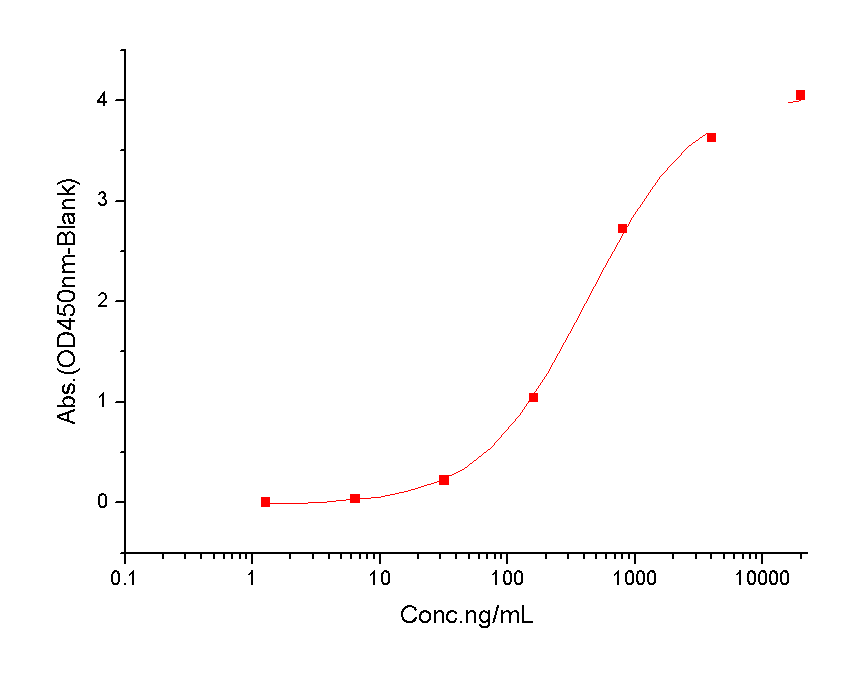Shopping Cart
- Remove All

Your shopping cart is currently empty

| Pack Size | Price | Availability | Quantity |
|---|---|---|---|
| 100 μg | $451 | In Stock | |
| 200 μg | $720 | 7-10 days | |
| 500 μg | $1,330 | 7-10 days |
| Biological Information | Measured by its binding ability in a functional ELISA. Immobilized Cynomolgus NCR3 His at 2 μg/ml (100 μl/well) can bind Cynomolgus B7-H6 hFc, the EC50 of Cynomolgus B7-H6 hFc is 200-800 ng/mL.  |
| Description | NKp30/NCR3 Protein, Cynomolgus, Rhesus, Recombinant (His) is expressed in HEK293 mammalian cells with His tag. The predicted molecular weight is 14.3 kDa and the accession number is XP_005553604.1. |
| Species | Cynomolgus,Rhesus |
| Expression System | HEK293 Cells |
| Tag | C-His |
| Accession Number | XP_005553604.1 |
| Synonyms | natural cytotoxicity triggering receptor 3 |
| Construction | The cynomolgus / rhesus NCR3 (XP_005553604.1) (Met1-Gly135) was expressed with a polyhistidine tag at the C-terminus. Cynomolgus and Rhesus NCR3 sequences are identical. |
| Protein Purity | > 90 % as determined by SDS-PAGE.  |
| Molecular Weight | 14.3 kDa (predicted) |
| Endotoxin | < 1.0 EU/μg of the protein as determined by the LAL method. |
| Formulation | Lyophilized from a solution filtered through a 0.22 μm filter, containing PBS, pH 7.4. Typically, a mixture containing 5% to 8% trehalose, mannitol, and 0.01% Tween 80 is incorporated as a protective agent before lyophilization. |
| Reconstitution | A Certificate of Analysis (CoA) containing reconstitution instructions is included with the products. Please refer to the CoA for detailed information. |
| Stability & Storage | It is recommended to store recombinant proteins at -20°C to -80°C for future use. Lyophilized powders can be stably stored for over 12 months, while liquid products can be stored for 6-12 months at -80°C. For reconstituted protein solutions, the solution can be stored at -20°C to -80°C for at least 3 months. Please avoid multiple freeze-thaw cycles and store products in aliquots. |
| Shipping | In general, Lyophilized powders are shipping with blue ice. |
| Research Background | Natural Cytotoxicity Triggering Receptor 3, NCR3, also known as NKp30, or CD337, is a natural cytotoxicity receptor, expressed on subsets of human peripheral blood NK cells, involved in NK cell killing of tumor cells and immature dendritic cells. The cellular ligand for NKp30 has remained elusive, but the membrane-associated heparan sulfate (HS) proteoglycans are involved in the recognition of cellular targets by NKp30 was recently reported. NKp30 is a member of the immunoglobulin superfamily and one of three existing natural cytotoxicity-triggering receptors. NKp30 is a glycosylated protein and is thought to be selectively expressed in resting and activated natural killer cells. NKp30 is a stimulatory receptor on human NK cells implicated in tumor immunity and is capable of promoting or terminating dendritic cell maturation. NCR3 may play a role in inflammatory and infectious diseases. |

Copyright © 2015-2024 TargetMol Chemicals Inc. All Rights Reserved.